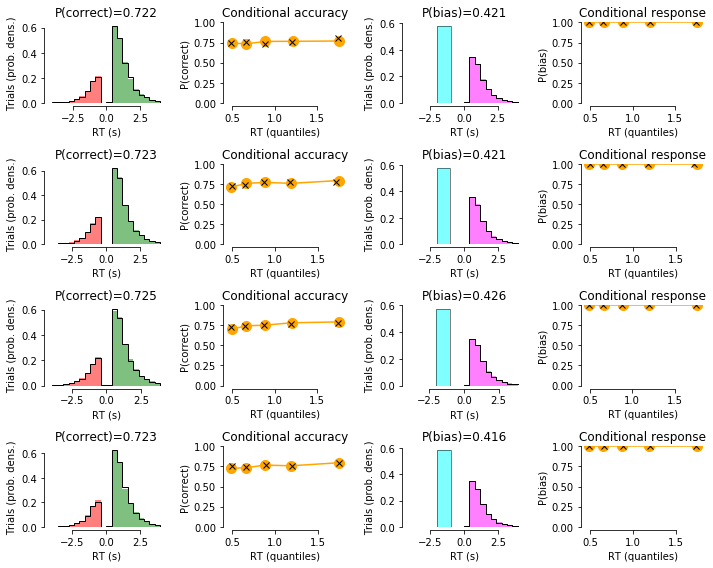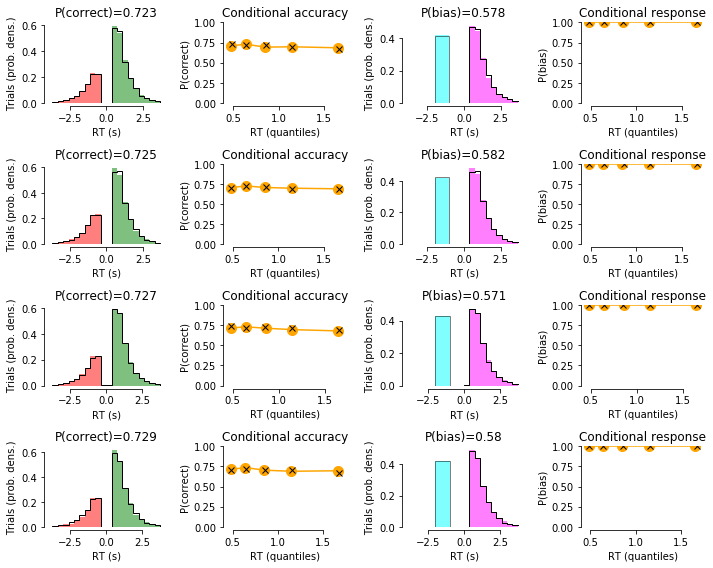Fitting go/no-go using the chi-qsuare approach
by Jan Willem de Gee (jwdegee@gmail.com)
This is a demo of fitting go/no-go data with HDDM using the chi-qsuare method, as described in
de Gee JW, Tsetsos T, McCormick DA, McGinley MJ & Donner TH. 2018. Phasic arousal optimizes decision computations in mice and humans. bioRxiv. (https://www.biorxiv.org/content/early/2018/10/19/447656).
See also
Ratcliff, R., Huang-Pollock, C., & McKoon, G. (2016). Modeling individual differences in the go/no-go task with a diffusion model. Decision, 5(1), 42-62 (http://psycnet.apa.org/record/2016-39470-001).
import sys, os
import numpy as np
import pandas as pd
import matplotlib.pyplot as plt
import seaborn as sns
import hddm
from joblib import Parallel, delayed
from IPython import embed as shell
Let’s start with defining some functionality
def get_choice(row):
if row.condition == 'present':
if row.response == 1:
return 1
else:
return 0
elif row.condition == 'absent':
if row.response == 0:
return 1
else:
return 0
def simulate_data(a, v, t, z, dc, sv=0, sz=0, st=0, condition=0, nr_trials1=1000, nr_trials2=1000):
"""
Simulates stim-coded data.
"""
parameters1 = {'a':a, 'v':v+dc, 't':t, 'z':z, 'sv':sv, 'sz': sz, 'st': st}
parameters2 = {'a':a, 'v':v-dc, 't':t, 'z':1-z, 'sv':sv, 'sz': sz, 'st': st}
df_sim1, params_sim1 = hddm.generate.gen_rand_data(params=parameters1, size=nr_trials1, subjs=1, subj_noise=0)
df_sim1['condition'] = 'present'
df_sim2, params_sim2 = hddm.generate.gen_rand_data(params=parameters2, size=nr_trials2, subjs=1, subj_noise=0)
df_sim2['condition'] = 'absent'
df_sim = pd.concat((df_sim1, df_sim2))
df_sim['bias_response'] = df_sim.apply(get_choice, 1)
df_sim['correct'] = df_sim['response'].astype(int)
df_sim['response'] = df_sim['bias_response'].astype(int)
df_sim['stimulus'] = np.array((np.array(df_sim['response']==1) & np.array(df_sim['correct']==1)) + (np.array(df_sim['response']==0) & np.array(df_sim['correct']==0)), dtype=int)
df_sim['condition'] = condition
df_sim = df_sim.drop(columns=['bias_response'])
return df_sim
def fit_subject(data, quantiles):
"""
Simulates stim-coded data.
"""
subj_idx = np.unique(data['subj_idx'])
m = hddm.HDDMStimCoding(data, stim_col='stimulus', split_param='v', drift_criterion=True, bias=True, p_outlier=0,
depends_on={'v':'condition', 'a':'condition', 't':'condition', 'z':'condition', 'dc':'condition', })
m.optimize('gsquare', quantiles=quantiles, n_runs=8)
res = pd.concat((pd.DataFrame([m.values], index=[subj_idx]), pd.DataFrame([m.bic_info], index=[subj_idx])), axis=1)
return res
def summary_plot(df_group, df_sim_group=None, quantiles=[0, 0.1, 0.3, 0.5, 0.7, 0.9,], xlim=None):
# # remove NaNs:
# df = df.loc[~pd.isna(df.rt),:]
# if df_sim is not None:
# df_sim = df_sim.loc[~pd.isna(df_sim.rt),:]
nr_subjects = len(np.unique(df_group['subj_idx']))
fig = plt.figure(figsize=(10,nr_subjects*2))
plt_nr = 1
for s in np.unique(df_group['subj_idx']):
print(s)
df = df_group.copy().loc[(df_group['subj_idx']==s),:]
df_sim = df_sim_group.copy().loc[(df_sim_group['subj_idx']==s),:]
df['rt_acc'] = df['rt'].copy()
df.loc[df['correct']==0, 'rt_acc'] = df.loc[df['correct']==0, 'rt_acc'] * -1
df['rt_resp'] = df['rt'].copy()
df.loc[df['response']==0, 'rt_resp'] = df.loc[df['response']==0, 'rt_resp'] * -1
df_sim['rt_acc'] = df_sim['rt'].copy()
df_sim.loc[df_sim['correct']==0, 'rt_acc'] = df_sim.loc[df_sim['correct']==0, 'rt_acc'] * -1
df_sim['rt_resp'] = df_sim['rt'].copy()
df_sim.loc[df_sim['response']==0, 'rt_resp'] = df_sim.loc[df_sim['response']==0, 'rt_resp'] * -1
max_rt = np.percentile(df_sim.loc[~np.isnan(df_sim['rt']), 'rt'], 99)
bins = np.linspace(-max_rt,max_rt,21)
# rt distributions correct vs error:
ax = fig.add_subplot(nr_subjects,4,plt_nr)
N, bins, patches = ax.hist(df.loc[:, 'rt_acc'], bins=bins,
density=True, color='green', alpha=0.5)
for bin_size, bin, patch in zip(N, bins, patches):
if bin < 0:
plt.setp(patch, 'facecolor', 'r')
if df_sim is not None:
ax.hist(df_sim.loc[:, 'rt_acc'], bins=bins, density=True,
histtype='step', color='k', alpha=1, label=None)
ax.set_title('P(correct)={}'.format(round(df.loc[:, 'correct'].mean(), 3),))
ax.set_xlabel('RT (s)')
ax.set_ylabel('Trials (prob. dens.)')
plt_nr += 1
# condition accuracy plots:
ax = fig.add_subplot(nr_subjects,4,plt_nr)
df.loc[:,'rt_bin'] = pd.qcut(df['rt'], quantiles, labels=False)
d = df.groupby(['rt_bin']).mean().reset_index()
ax.errorbar(d.loc[:, "rt"], d.loc[:, "correct"], fmt='-o', color='orange', markersize=10)
if df_sim is not None:
df_sim.loc[:,'rt_bin'] = pd.qcut(df_sim['rt'], quantiles, labels=False)
d = df_sim.groupby(['rt_bin']).mean().reset_index()
ax.errorbar(d.loc[:, "rt"], d.loc[:, "correct"], fmt='x', color='k', markersize=6)
if xlim:
ax.set_xlim(xlim)
ax.set_ylim(0, 1)
ax.set_title('Conditional accuracy')
ax.set_xlabel('RT (quantiles)')
ax.set_ylabel('P(correct)')
plt_nr += 1
# rt distributions response 1 vs 0:
ax = fig.add_subplot(nr_subjects,4,plt_nr)
if np.isnan(df['rt']).sum() > 0:
bar_width = 1
fraction_yes = df['response'].mean()
fraction_yes_sim = df_sim['response'].mean()
hist, edges = np.histogram(df.loc[:, 'rt_resp'], bins=bins, density=True,)
hist = hist * fraction_yes
hist_sim, edges_sim = np.histogram(df_sim.loc[:, 'rt_resp'], bins=bins, density=True,)
hist_sim = hist_sim * fraction_yes_sim
ax.bar(edges[:-1], hist, width=np.diff(edges)[0], align='edge',
color='magenta', alpha=0.5, linewidth=0,)
# ax.plot(edges_sim[:-1], hist_sim, color='k', lw=1)
ax.step(edges_sim[:-1]+np.diff(edges)[0], hist_sim, color='black', lw=1)
# ax.hist(hist, edges, histtype='stepfilled', color='magenta', alpha=0.5, label='response')
# ax.hist(hist_sim, edges_sim, histtype='step', color='k',)
no_height = (1 - fraction_yes) / bar_width
no_height_sim = (1 - fraction_yes_sim) / bar_width
ax.bar(x=-1.5, height=no_height, width=bar_width, alpha=0.5, color='cyan', align='center')
ax.hlines(y=no_height_sim, xmin=-2, xmax=-1, lw=0.5, colors='black',)
ax.vlines(x=-2, ymin=0, ymax=no_height_sim, lw=0.5, colors='black')
ax.vlines(x=-1, ymin=0, ymax=no_height_sim, lw=0.5, colors='black')
else:
N, bins, patches = ax.hist(df.loc[:, 'rt_resp'], bins=bins,
density=True, color='magenta', alpha=0.5)
for bin_size, bin, patch in zip(N, bins, patches):
if bin < 0:
plt.setp(patch, 'facecolor', 'cyan')
ax.hist(df_sim.loc[:, 'rt_resp'], bins=bins, density=True,
histtype='step', color='k', alpha=1, label=None)
ax.set_title('P(bias)={}'.format(round(df.loc[:, 'response'].mean(), 3),))
ax.set_xlabel('RT (s)')
ax.set_ylabel('Trials (prob. dens.)')
plt_nr += 1
# condition response plots:
ax = fig.add_subplot(nr_subjects,4,plt_nr)
df.loc[:,'rt_bin'] = pd.qcut(df['rt'], quantiles, labels=False)
d = df.groupby(['rt_bin']).mean().reset_index()
ax.errorbar(d.loc[:, "rt"], d.loc[:, "response"], fmt='-o', color='orange', markersize=10)
if df_sim is not None:
df_sim.loc[:,'rt_bin'] = pd.qcut(df_sim['rt'], quantiles, labels=False)
d = df_sim.groupby(['rt_bin']).mean().reset_index()
ax.errorbar(d.loc[:, "rt"], d.loc[:, "response"], fmt='x', color='k', markersize=6)
if xlim:
ax.set_xlim(xlim)
ax.set_ylim(0,1)
ax.set_title('Conditional response')
ax.set_xlabel('RT (quantiles)')
ax.set_ylabel('P(bias)')
plt_nr += 1
sns.despine(offset=3, trim=True)
plt.tight_layout()
return fig
Let’s simulate our own data, so we know what the fitting procedure should converge on:
# settings
go_nogo = True # should we put all RTs for one choice alternative to NaN (go-no data)?
n_subjects = 4
trials_per_level = 10000
# parameters:
params0 = {'cond':0, 'v':0.5, 'a':2.0, 't':0.3, 'z':0.5, 'dc':-0.2, 'sz':0, 'st':0, 'sv':0}
params1 = {'cond':1, 'v':0.5, 'a':2.0, 't':0.3, 'z':0.5, 'dc':0.2, 'sz':0, 'st':0, 'sv':0}
# simulate:
dfs = []
for i in range(n_subjects):
df0 = simulate_data(z=params0['z'], a=params0['a'], v=params0['v'], dc=params0['dc'],
t=params0['t'], sv=params0['sv'], st=params0['st'], sz=params0['sz'],
condition=params0['cond'], nr_trials1=trials_per_level, nr_trials2=trials_per_level)
df1 = simulate_data(z=params1['z'], a=params1['a'], v=params1['v'], dc=params1['dc'],
t=params1['t'], sv=params1['sv'], st=params1['st'], sz=params1['sz'],
condition=params1['cond'], nr_trials1=trials_per_level, nr_trials2=trials_per_level)
df = pd.concat((df0, df1))
df['subj_idx'] = i
dfs.append(df)
# combine in one dataframe:
df_emp = pd.concat(dfs)
if go_nogo:
df_emp.loc[df_emp["response"]==0, 'rt'] = np.NaN
Fit using the g-quare method.
# fit chi-square:
quantiles = [.1, .3, .5, .7, .9]
params_fitted = pd.concat(Parallel(n_jobs=n_subjects)(delayed(fit_subject)(data[1], quantiles)
for data in df_emp.groupby('subj_idx')))
print(params_fitted.head())
a(0) a(1) v(0) v(1) t(0) t(1) z_trans(0) 0 2.014264 1.982307 0.491241 0.500920 0.302303 0.303157 0.017545
1 2.012188 1.991561 0.500171 0.507074 0.321398 0.305079 0.112512
2 2.026892 1.979547 0.497864 0.509328 0.313958 0.303418 0.087991
3 2.001516 2.002651 0.501016 0.514810 0.305864 0.311847 0.046943
z_trans(1) z(0) z(1) dc(0) dc(1) bic 0 -0.005189 0.504386 0.498703 -0.208985 0.201551 115950.224101
1 0.012872 0.528098 0.503218 -0.258731 0.204944 116056.073161
2 -0.016963 0.521984 0.495759 -0.236325 0.191737 115756.146165
3 0.054819 0.511734 0.513701 -0.241030 0.177703 115425.608585
likelihood penalty
0 -115823.064484 127.159617
1 -115928.913544 127.159617
2 -115628.986548 127.159617
3 -115298.448968 127.159617
params_fitted.drop(['bic', 'likelihood', 'penalty', 'z_trans(0)', 'z_trans(1)'], axis=1, inplace=True)
print(params_fitted.head())
a(0) a(1) v(0) v(1) t(0) t(1) z(0) 0 2.014264 1.982307 0.491241 0.500920 0.302303 0.303157 0.504386
1 2.012188 1.991561 0.500171 0.507074 0.321398 0.305079 0.528098
2 2.026892 1.979547 0.497864 0.509328 0.313958 0.303418 0.521984
3 2.001516 2.002651 0.501016 0.514810 0.305864 0.311847 0.511734
z(1) dc(0) dc(1)
0 0.498703 -0.208985 0.201551
1 0.503218 -0.258731 0.204944
2 0.495759 -0.236325 0.191737
3 0.513701 -0.241030 0.177703
# simulate data based on fitted params:
dfs = []
for i in range(n_subjects):
df0 = simulate_data(a=params_fitted.loc[i,'a(0)'], v=params_fitted.loc[i,'v(0)'],
t=params_fitted.loc[i,'t(0)'], z=params_fitted.loc[i,'z(0)'],
dc=params_fitted.loc[i,'dc(0)'], condition=0, nr_trials1=trials_per_level,
nr_trials2=trials_per_level)
df1 = simulate_data(a=params_fitted.loc[i,'a(1)'], v=params_fitted.loc[i,'v(1)'],
t=params_fitted.loc[i,'t(1)'], z=params_fitted.loc[i,'z(1)'],
dc=params_fitted.loc[i,'dc(1)'], condition=1, nr_trials1=trials_per_level,
nr_trials2=trials_per_level)
df = pd.concat((df0, df1))
df['subj_idx'] = i
dfs.append(df)
df_sim = pd.concat(dfs)
if go_nogo:
df_sim.loc[df_sim["response"]==0, 'rt'] = np.NaN
# plot true vs recovered parameters:
x = np.arange(5) * 2
y0 = np.array([params0['a'], params0['v'], params0['t'], params0['z'], params0['dc']])
y1 = np.array([params1['a'], params1['v'], params1['t'], params1['z'], params1['dc']])
fig = plt.figure(figsize=(5,2))
ax = fig.add_subplot(111)
ax.scatter(x, y0, marker="o", s=100, color='orange', label='True value')
ax.scatter(x+1, y1, marker="o", s=100, color='orange',)
sns.stripplot(data=params_fitted, jitter=False, size=2, edgecolor='black', linewidth=0.25, alpha=1, palette=['black', 'black'], ax=ax)
plt.ylabel('Param value')
plt.legend()
sns.despine(offset=5, trim=True,)
plt.tight_layout()

# plot data with model fit on top:
for c in np.unique(df_emp['condition']):
print()
print()
print('CONDITION {}'.format(c))
summary_plot(df_group=df_emp.loc[(df_emp['condition']==c),:],
df_sim_group=df_sim.loc[(df_emp['condition']==c),:])
CONDITION 0
0
1
2
3
CONDITION 1
0
1
2
3

